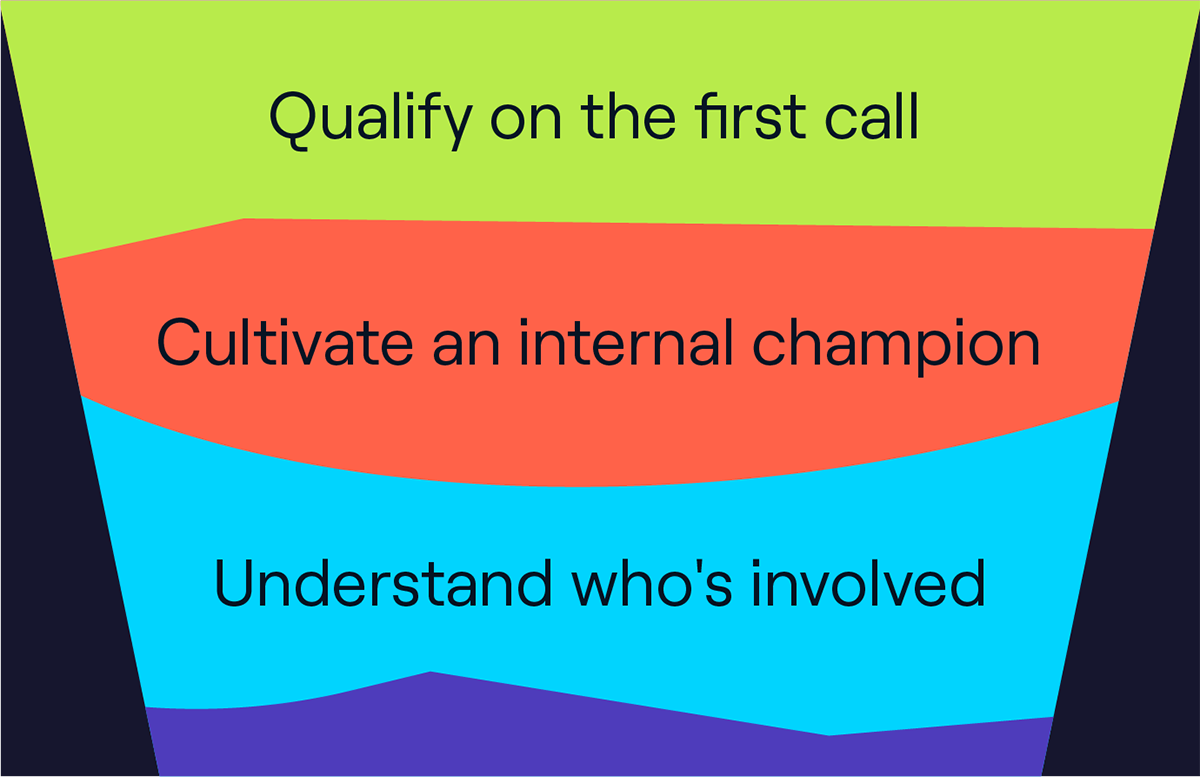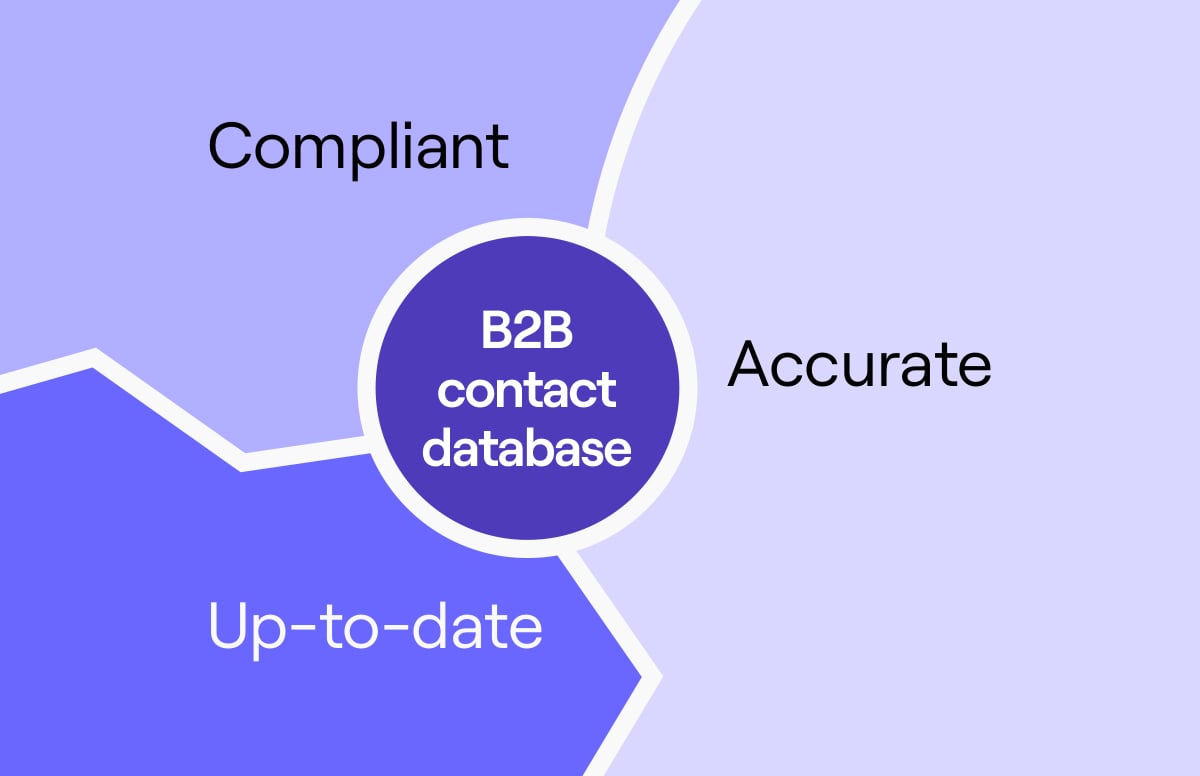How To Find Business Decision Makers for Prospecting
6 ways to find business decision-makers:
The most compelling offer will still fall flat if you’re pitching to the wrong person. Or if that person has little influence over budget.
In other words:
Failing to recognise key business decision-makers will waste your sales team’s time and resources.
In this article, we share best practices for finding, identifying, and pitching real business decision-makers.
Here are six ways of finding key decision-makers at a company:
1. Use sales intelligence
Sales intelligence platforms can save your sales team days of prospecting to the wrong contacts. With advanced company and contact filters, you can easily build account lists that fit your ideal customer profile.
Cognism Sales Companion is a leading sales intelligence tool. Its Job Title and Seniority filters help you find prospects responsible for making business decisions at a company.
How does it work?
- Our AI analyses company structures and the relationships between job titles, picking out the most relevant and senior people in a company.
- Use Cognism’s signal data to act on sales triggers, such as hiring trends, funding rounds, or job changes.
- Then, you can easily export business prospect data to your CRM or sales enablement tool.
Never miss an opportunity with Sales Companion - take an interactive tour 👇
Want to hear from a Cognism customer?
The enterprise AI solution Expert.ai tested Cognism against its competitors - see below for the verdict 👇

Global Head of Inside Sales @Expert.ai
2. Research the company’s website
The year is 2025 - you don’t need to manually research company websites anymore!
Use Cognism’s Browser Extension to view key account and lead information, such as decision-maker contact details, their company details, and the technology they use, without leaving your browser.
Our extension also allows you to tap into your prospect’s network, surfacing key stakeholders and helping you close multithread sales deals.
It’s a quick and accurate way of sourcing information about business decision-makers.
The alternative - scouring the company’s website and social media profiles - is long and time-consuming!
Here’s what a Cognism customer said about using the Browser Extension:
.jpg?width=100&height=100&name=KACIMI_EL-HADI%20(1).jpg)
Business Developer @Axys
3. Research LinkedIn
Another good way to find a company’s decision-makers is to look at its LinkedIn page. There, you can find a list of its employees and search it until you find the decision-makers you’re after.
But again, this is a very time-consuming procedure. As a sales manager, do you really want your reps wasting hours doing this?
The Cognism Browser Extension doesn’t just work on company websites - it works on LinkedIn profiles, too! Simply install the extension, click on any LinkedIn page, and you’ll get critical intel such as:
- Decision-maker contact details, including direct dial phone numbers and business email addresses.
- Company details, including headcount, revenue, and HQ location.
- The latest buying signals, such as recent job changes or acquisitions.
- A list of recommended people to contact inside the company.
4. Track job change triggers
You can track job title changes and new hire events to know immediately when a company appoints a new executive to a decision-making position.
This means you can start building relationships with them from day one, outpacing your competitors.
Here’s a stat to remember:
On average, new executives decide where to spend 70% of their budget within their first 100 days. So the sooner your reps get them on a cold call, the better!
⚠️ Cognism includes job change data as part of its Elevate package. Click here to see Cognism’s pricing.
5. Use intent data
Another good way of finding business decision-makers is to rely on intent data.
Intent data tools monitor the online content consumed by individuals at an organisation and their social media engagement. They provide insights into a prospect’s level of buying intent.
With intent data, you can identify which prospects are actively researching your products or services or those of a competitor. These insights allow your sales team to call those people and qualify them.
And when you use intent data and buying signals together, your team will know exactly who is ready to buy and when to reach out.
George McKenna of Ultima told about his experience combining Cognism’s database with intent data to identify decision-makers:

Head of Cloud Sales @Ultima
6. Enrich your prospect list
No prospect list is perfect on the first try.
After you’ve constructed the first draft of your list of potential decision-makers in a company, spend some time on lead enrichment.
It can save your sales team from wasting hours on dialling the wrong numbers, speaking to the incorrect people, or emailing outdated email addresses.
Use Cognism Enrich to clean and update your prospect lists:
- Update your existing contact database with CSV enrichment - just upload your CSV file, and Cognism fills in the missing info!
- Get direct access to Cognism’s data wherever you need it via our enrichment API.
- Maintain and improve the sales data your reps use every day.
⚠️ Click the link to find out more about Cognism Enrich.
FAQs
Who are a company’s decision-makers?
A company’s key decision-makers are the individuals who have the power to make strategic purchasing decisions, like what to buy and at what price.
In B2B organisations, they usually hold C-level positions and their decisions impact how their departments operate.
Understanding who you’re selling to - including their pain points and needs - saves time and effort. If you’re selling a complex business-to-business solution, the purchasing decision will likely involve six to ten decision-makers, not just one.
Nowadays, it’s important to engage in C-suite selling; that is, prospecting to the whole of the B2B buying committee.
What qualifying questions should you ask decision-makers?
Even with the appropriate title and ideal customer profile qualities, not every lead you speak with will be a decision-maker for their company.
This is where qualifying questions come into play, as they help with:
- What a lead needs to know about a solution.
- How to identify the proper prospect to contact to make a sale.
Several qualifying questions can enable sales teams to pinpoint company decision-makers, such as:
- Who is the end user of the product?
- Aside from yourself, who else will be involved in this decision?
- Are you the only decision-maker or is there a committee involved?
- What’s the typical purchasing process for a product in this category?
- Aside from your department, what other departments would regularly use the product?
- Who can I explain this solution to as well that might have a say in the final purchase decision?
How should you pitch to decision-makers?
With a vetted prospect list of decision-makers, you can finally begin pitching. Now that you’ve worked to identify and find the right individuals, you want your approach to shine.
Consider these four tips for pitching decision-makers at a company:
1. Learn as much as possible
Sales pitch research shouldn’t stop once you locate the company’s decision-makers.
Instead, you should strive to learn as much as possible about the company you’re pitching to. You must craft a proposal that’s hyper-personalised to their unique needs.
For example:
Learning that a company has recently completed an international merger or received a round of funding can and should influence your pitch.
2. Leverage the gatekeeper
Most decision-makers are guarded by gatekeepers, especially at large companies.
Gatekeepers are the employees who stand between sales teams and decision-makers. These individuals can take many forms, from an assistant or a secretary to a junior manager.
Take the time to befriend the gatekeeper. Ask them qualifying questions; their answers will help you craft the perfect pitch for their boss.
3. Locate mutual connections
Your sales prospects likely receive dozens, if not hundreds, of pitches every quarter. One method to cut through the chatter is to use mutual connections to drum up a conversation.
From shared connections on professional networks like LinkedIn to current customers who share educational or professional history with a prospect, harness mutual connections to your advantage.
For more advice, check out Cognism’s blog on LinkedIn prospecting.
4. Automate the tedious stuff
Your reps should spend most of their time talking with key decision-makers. But how can you make that happen when there’s so much admin to be done?
Sales automation is the way forward!
Here’s an example:
Many LinkedIn tasks can be automated without sacrificing quality, like exporting lead lists to your CRM or scheduling status updates or initial outreach messages.
⚠️ Learn how Cognism’s LinkedIn Browser Extension automates the viewing and exporting of lead lists.
5. Lead with value
With tons of pitches clogging decision-makers’ email inboxes and voicemails, it’s always wise to lead a pitch with value.
Front-load your pitch with your unique selling proposition; this will capture buy-in as soon as possible.
For instance:
If you’re targeting a B2B decision-maker who has just started a new role, send them content via email and LinkedIn ads that will help them in their first 90 days.
Leading with value is always a great idea when outreaching to decision-makers.
Key takeaways
A pitch without understanding a company’s decision makers is a pitch without purpose.
When it comes to finding and identifying decision-makers in a business, the key is to do your research first. Just one hour of preparation can save your sales team from hours of misdirected prospecting.
But instead of manually researching the company’s decision-makers, use Cognism! Our sales intelligence platform gives you up-to-date, quality data for the companies and decision-makers who matter most 👇
/CTAs%20(SEO)/EN_high-intent-cta-banners-data-sample-webp.webp?width=1000&height=384&name=EN_high-intent-cta-banners-data-sample-webp.webp)


